
1,150 Sq Ft | 2 BD, 2BA | $799,000
Subtle Deco details, high beamed ceilings*
Large eat-in kitchen, roof deck with views of the GWB*
250 Cabrini Boulevard - Corcoran - (212)875-2877
from
http://www.corcoran.com/nyc/Listings/Display/3671820

1,150 Sq Ft | 2 BD, 2BA | $799,000
Subtle Deco details, high beamed ceilings*
Large eat-in kitchen, roof deck with views of the GWB*
250 Cabrini Boulevard - Corcoran - (212)875-2877

$4,500 1BR no fee apartment with*
Huge private outdoor patio, Oversized windows*
High ceilings and hardwood floors, central air*
882 Metropolitan - Corcoran - (973) 277-0273

It will rise next to St. Mary’s Episcopal Church and bring 142 apartments to the neighborhood
Clinton Hill isn’t the first neighborhood you envision a 16-story residential tower in, but the forces of gentrification tend to leave nothing untouched for too long. The residential building will rise on the property of St. Mary’s Episcopal Church at 230 Classon Avenue, The Real Deal reports.
The building will have 142 apartments, and replace the 4,800-square-foot rectory building that sits across from the church at the site. The church is collaborating with an unnamed developer on the project, and architecture firm DXA Studio has been roped in to design the structure.
Aside from the apartments, the Church plans use to about 25,200 square feet of the building as a community facility, and there are also plans for a coffee shop, a library, space for a priest’s office, and parking for 93 cars.
Plans for the building were just filed today, and the timeline on this project is not yet clear. For the church however, this is the time to capitalize on the favorable real estate market.
"This is the moment in Brooklyn to capitalize and to use real estate if you have it," the priest in charge at the church told TRD. "The area is very different from what it was 30 years ago."

The 46-story tower will have 358 hotel rooms and 131 apartments
Looks like it’s the week for Hudson Yards skyscrapers to move forward. After the revelation yesterday that Bjarke Ingels’s office tower was officially moving ahead , the Chetrit Group has now filed plans for its project on West 37th Street, The Real Deal reports.
Plans filed Friday with the city’s Department of Buildings reveal a 622-foot tower that will rise at 545 West 37th Street, right across from the Javits Center, and closer to Eleventh Avenue.
The CetraRuddy-designed building will have a hotel on the lower floors, and apartments above that. In all, the project will span 373,275 square feet and come with 358 hotel rooms and 131 apartments.
The hotel will be spread out on floors nine through 27 of this 46-story building. Floors 32 and above will house the apartments. The lobby will take up all of the first floor. There will be a restaurant, an event space, and probably a bar on the second floor. Amenities announced for the project so far include the usual suspects like a resident’s lounge (on the 30th floor) and a fitness center equipped with a yoga and pilates studio.
Chetrit had at one point considered selling the site, but took it off the market last August.

The meeting, as City Council hearings tend to go, was drama packed
A City Council hearing Thursday surrounding the Rivington House fiasco produced all the drama one might expect when city officials butt heads. First Deputy Mayor Anthony Shorris was grilled for 2.5 hours by the Council, and essentially shouldered the blame for everything that went wrong after the deed restrictions were lifted on the Lower East Side nursing home.
Overall, the hearing lasted six hours, the New York Times reported with several other members of Mayor Bill de Blasio’s administration also questioned. There were questions about competency. City Coucilman Ben Kallos wondered how Shorris could do his job properly when he had to oversee 30 different city agencies, according to the Wall Street Journal.
There were questions over the timeline. De Blasio had previously stated that he only became aware of the whole wrongdoing towards the end of March, whereas Shorris’s testimony on Thursday seemed to suggest that it was towards the end of February or early March, according to the New York Post.
And then there were questions about the communication between the Mayor’s office and the Department of Citywide Administrative Services, the city agency directly responsible for lifting or modifying deed restrictions. Shorris admitted that he failed to follow up with the then head of the Department, Stacey Cumberbatch, and failed to be explicit, according to DNAinfo. For instance, there were two restrictions on the property, one maintaining its non-profit status and the other as a healthcare facility. The city could have just lifted the non-profit restriction, as the previous owner of the building, the Allure Group, is a for-profit healthcare provider.
Did the hearing produce any kind of resolution? Nope. It was the first big public meeting on the whole debacle however, and it did allow the de Blasio administration to reiterate that it was changing its policies in regards to deed modification. Just as the hearing got underway, de Blasio announced that the administration was planning a new senior home along with a medical facility on the Lower East Side, as a peace offering of sorts for this mess up.
Of course, no City Council hearing would be complete without some added drama and silly squabbling. The Council and de Blasio administration traded barbs over an alleged miscommunication. The Council was apparently told that Shorris would only be able to stay for 2.5 hours and then had to leave for Oklahoma for a mayor’s conference. City Hall however denied any such missive and said no time limit had been set, but that Shorris had to assume the mayor’s responsibilities since the latter was traveling.
On Friday morning, State Senator Daniel Squadron and Democratic nominee to the Assembly Yuh-Line Niou announced a new bill, the "Rivington Act," which is looking to install more protections for nursing homes and ensure that there is a stringent community process whenever nursing homes are threatened.

Would you choose the Upper West Side or Soho?
Imagine you have around $23,000/month to spend on a place and you've narrowed it down to two apartments. How do you make up your mind? The answer is simple: you shove them into a metaphorical cage and let them battle it out until one emerges victorious. It's time for Real Estate Deathmatch.
| Address: | The Apthorp - 2211 Broadway | 145 Spring Street |
| Price: | $24,000/month | $22,000/month |
| Square footage: | 3,000 | 3,000 |
| Type: | Apartment | Apartment |
| Beds, Baths: | 4, 3 | 3, 3 |
↑ A corner apartment in Upper West Side legend The Apthorp is seeking $24,000/month. The apartment appears to have been recently refurbished—that kitchen!—and offers up classic-cool finishes like herringbone floors and crystal chandeliers. As is common with older apartments, there’s no short supply of wood-burning fireplaces in the apartment. This one boasts three of ‘em.
↑ A spacious penthouse in the heart of Soho on Spring Street between West Broadway and Wooster streets that, according to its listings, is a "former private residence of an American Legend" is on the market for $22,000/month. Where The Apthorp apartment is very Upper West Side, this pad is distinctly downtown with soaring ceilings, clean lines, and a bedroom that look onto a double-height living area. But don’t worry, that’s not the master; the master, of course, has great vistas onto the surrounding neighborhood. This one also has a deck.
<a href="http://polldaddy.com/poll/9538028/" mce_href="http://polldaddy.com/poll/9538028/">Which apartment would you choose?</a>
Would you choose the Upper West Side or Soho?
Imagine you have around $23,000/month to spend on a place and you've narrowed it down to two apartments. How do you make up your mind? The answer is simple: you shove them into a metaphorical cage and let them battle it out until one emerges victorious. It's time for Real Estate Deathmatch.
| Address: | The Apthorp - 2211 Broadway | 145 Spring Street |
| Price: | $24,000/month | $22,000/month |
| Square footage: | 3,000 | 3,000 |
| Type: | Apartment | Apartment |
| Beds, Baths: | 4, 3 | 3, 3 |
↑ A corner apartment in Upper West Side legend The Apthorp is seeking $24,000/month. The apartment appears to have been recently refurbished—that kitchen!—and offers up classic-cool finishes like herringbone floors and crystal chandeliers. As is common with older apartments, there’s no short supply of wood-burning fireplaces in the apartment. This one boasts three of ‘em.
↑ A spacious penthouse in the heart of Soho on Spring Street between West Broadway and Wooster streets that, according to its listings, is a "former private residence of an American Legend" is on the market for $22,000/month. Where The Apthorp apartment is very Upper West Side, this pad is distinctly downtown with soaring ceilings, clean lines, and a bedroom that look onto a double-height living area. But don’t worry, that’s not the master; the master, of course, has great vistas onto the surrounding neighborhood. This one also has a deck.
<a href="http://polldaddy.com/poll/9538028/" mce_href="http://polldaddy.com/poll/9538028/">Which apartment would you choose?</a>
It would run from Elm Park to Bayonne, New Jersey and connect to Manhattan via the PATH train
Earlier this year, Staten Island’s Economic Development Corporation (SIEDC) launched a design competition soliciting submissions for an aerial tram that would connect the borough to the surrounding areas. Last week, the organization picked a winner—Colarado’s Leitner-Poma of America (LPOA), which is known for its cable transport systems, Staten Island Live first reported.
The plan? To connect the Elm Park neighborhood in Staten Island to Bayonne in New Jersey with an aerial gondola that runs parallel to the Bayonne Bridge. The gondola would run from Staten Island and connect to the Eight Street station on the Hudson-Bergen Light Rail, and from here commuters would connect to a PATH train, and subsequently make their way to Manhattan. The developers estimate that the total travel time between Staten Island and Manhattan would be 33 minutes.
Other proposals submitted included routes between St. George and Lower Manhattan, another one from Fort Wadsworth to the 95th Street R train station, and a third that would also leave from St. George, but make a stop at Governor’s Island on the way.
The SIEDC however deemed LPOA’s the most efficient overall in terms of cost, travel time, and the construction required. LPOA’s proposal would cost about $60 million, which would all come through private funding. A proposal to extend the light rail on the Bayonne Bridge in contrast could cost as much as $1 billion.
Both Staten Island and New Jersey residents however were not too impressed. The opinions in Staten Island varied with some saying more ferries would be just fine, and others saying they prefer the light rail. In Bayonne, elected officials said the plan as it is now wouldn’t be very feasible, and residents were already concerned about the amount of ongoing construction on the Bayonne Bridge.
The president of the SIEDC however told SILIVE that a comprehensive proposal would be unveiled next spring before the agency considers moving forward. In the meantime they will be working on a feasibility study of the project, according to Untapped Cities.

The iconic Jewish deli will shutter after a series of bad breaks
Say goodbye to another New York City icon. The New York Post reports that the Carnegie Deli, which has been slinging pastrami sandwiches and fat slices of cheesecake since 1937, will close by the end of the year. Owner Marian Harper Levine announced the news this morning, telling the Post that "I’m very sad to close the Carnegie Deli but I’ve reached the time of my life when I need to take a step back."
But unlike other instances of an long-running New York institution shutting its doors—Rizzoli Bookstore, for instance, or Pearl Paint on Canal Street—the closure isn’t necessarily motivated by real estate interests. As the Post points out, the deli’s owners also own the building it’s located in.
Rather, a series of unfortunate events have happened in the past few years, including a 2015 gas leak that temporarily closed the restaurant in 2015; a lawsuit over missing wages owed to employees; and a bitter divorce with Levine’s ex-husband, Sandy.
Though, as Eater points out, the deli has become "a massive tourist trap complete with hokey novelty dishes, inflated prices, and a nonsensical sharing charge," its place in the canon of New York institutions has long been secured. And no doubt there will be many that eulogize its demise, which comes on the heels of other long-running businesses that have closed this year: Central Art Supply in the Village, Tekserve, Rebel Rebel, and so on.
As for Harper Levine, she plans to "keep her father’s legacy alive by focusing on licensing the iconic Carnegie Deli brand and selling their world-famous products for wholesale distribution," according to a spokesperson.

1,260 Sq Ft | 2 BD, 2BA | $1,050,000*
Open kitchen, pine floors, breakfast bar*
Large closets, soaker tub, doorman*
West 158th street - Corcoran - (212) 875-2877

2,975 Sq Ft | 3 BD, 3.5 BA | $13,850,000*
Completely park facing, bedrooms with en suites*
Access to full hotel amenities and private gardens*
1 Central Park South - Corcoran - (917) 612-6258

1,466 Sq Ft | 1 BD, 2 BA | $2,895,000*
Western views of the Harbor and High Line*
Open floor plan with almost 20 foot ceilings*
456 West 19th - Corcoran - (212) 401-1902

4 Bedrooms, 3.5 Baths, $9,250,000*
Chef's kitchen with panoramic views of lower Manhattan*
Central air, Skylight, Private 2,000 sq ft roof deck*
30 West 15th Street - Corcoran - (212) 539-4969

5,984 Sq Ft | 7 BD, 4 BA | $5,500,000*
Expansive floor plan with original pre-war details*
34-foot wide, Parlor floor with soaring 12’ ceilings*
16 2nd Place - The Corcoran Group - (917)345-3778

2,830 Sq Ft | 5 BD, 3.5 BA | $5,495,000*
Modern loft-style living with full city view*
2,071 Sq Ft of an outdoor private space*
325 Henry Street - Corcoran - (718) 923-8001

The enormous townhouse on North Moore Street is back
Given the saga of the enormous townhouse at 2 North Moore Street—famously (infamously?) referred to as "our suburb" by the original owners back in 2005—it’s no surprise that we’re at the point of "market the place as a luxury rental" in its life cycle.
To briefly recap: The sprawling, 11,300-square-foot home was originally built nearly a decade ago, but the couple who created it (and compared it to suburban sprawl in Manhattan) listed it in 2008 for a whopping $35 million. It then went through a series of ups and downs: de-listed in 2008, then re-listed in 2009, then finally sold in 2010.
But the story doesn’t end there! It reappeared on the market in 2014 for an even more bonkers $48 million, and has since gotten a couple of price cuts since. Right now, it’s asking $38 million—a $10 million reduction from two years ago—but it’s also on the rental market for a totally lol-worthy $97,500/month.
So what would one get if one were to conceivably pay $1.17 million a year to rent the place? So much! Here’s a small smattering of the home’s amenities, from the listing:
7 central air units plus central vac, air and water purification, radiant heated walnut hardwood floors, one-touch state-of-the-art audio, video and security, a top-floor gym with a 50' indoor heated swimming pool, full house generator and 3-car garage.
Oh, and this:
6 bedrooms, 7 full baths, 4 powder rooms, 3 fireplaces, an elegant formal living room, a professional Molteni Dada chef's kitchen, sun-drenched art studio, staff apartment with separate entrance, stately den/library, screening and billiards room, tranquil outdoor dining atrium, full laundry room, finished lower level, enormous storage areas, and the list goes on
The list goes on indeed. But it remains to be seen if this will be the thing that attracts a new, wanna-be suburban resident once and for all.

The new building will house over 100 seniors, and a medical care facility
The scandal surrounding the sale of Rivington House on the Lower East Side has far from died down, and in fact members of the de Blasio administration are currently facing a fierce round of questioning in City Hall over the whole debacle. But as a peace offering of sorts, the Mayor today announced a senior affordable housing and health care facility that will essentially replace the services lost at Rivington House.
Sometime next year, the city will issue a Request for Proposals (RFP) for this project, which will be located next to the Manhattan Bridge at 30 Pike Street. That site is owned by the city’s Department of Environmental Protection, and appears to be the location of a water supply building, and a Manhattan Repair Company Headquarters structure. It’s a relatively large plot of land, and google maps reveals a parking lot of sorts next to the existing structure.
As per the mayor’s office’s description, the property, "will be reconfigured to accommodate the new project as well as DEP’s operations." The project is located less than mile away from Rivington House, and the administration has vowed to spend more than the $16 million it received for lifting the deed restrictions on Rivington House, for the affordable housing project.
"Rivington House’s conversion to luxury housing never should have happened," Bill de Blasio said in a statement. "This community was the victim of a broken process, City error and unscrupulous developers looking to make a buck. Our reforms will prevent that from ever happening again. This investment is a reflection of our unwavering commitment to the health of this neighborhood."
This new building will be able to accommodate 100 seniors, and will have space for a health care facility. After agreeing to reform the deed modification process this past summer, this is another conciliatory effort on the part of the administration to counter the anger and frustration created by the Rivington House saga.

Market-rate units in the MoMA PS1-facing building are going for quite a bit more than that
The Department of Housing and Preservation is now accepting applications for 35 affordable units at the ODA New York-designed rental building at 22-22 Jackson Avenue in Long Island City. Developed by Jeffrey Gershon and dubbed 2222 Jackson, the 11-story building holds 175 apartments, ranging from studios to three-bedrooms. Leasing for market-rate units launched earlier this year and Streeteasy shows two units currently up for grabs: a penthouse one-bedroom asking $3,185/month, and another one-bedroom asking $3,150/month.
As for the affordable units, there are 10 studio apartments priced at $850/month; 16 one-bedrooms priced at $913/month; six two-bedrooms for $1,105/month; and finally three three-bedrooms for $1,274/month. To qualify, you must have an annual household earning of between $29,143 and $63,060, depending on the type of unit you’re applying for. To see the full restrictions, go here [PDF].
The 2222 Jackson website details that units come with floor-to-ceiling windows, white oak flooring, Bosch appliances, HVAC central air and washer/dryers on every floor. Amenities include a two-story lobby, lounge, library space, gym, indoor pool, landscaped courtyard and roof deck. Some of the apartments come with terraces, as well. As an added bonus, the building’s located right across from MoMA PS1.

One of Mayor de Blasio’s appointees wants to know where the MTA’s share is coming from
At least one MTA board member has concerns about Governor Andrew Cuomo’s newly unveiled plans to revamp Penn Station, reports the Wall Street Journal.
"This agency has been stressed significantly over the past few years," said de Blasio appointee Veronica Vanterpool at the first board meeting since Cuomo presented the plan. "I’m concerned about any additional projects that were not originally identified as priorities now becoming priorities."
The WSJ breaks down the numbers: As it currently stands, the MTA would be responsible for more than $150 million of the $1.5 billion plan to create a new 255,000-square-foot train hall in the James A. Farley post office building, across the street from what is now Penn Station. The agency’s funding will go towards "the comprehensive redesign of the LIRR’s existing 33rd Street concourse at Penn Station and an extensive renovation to the adjacent Seventh and Eighth Avenue subway stations," according to the detailed plans released by the Governor’s office earlier this week.
But it isn’t necessarily clear how exactly the MTA will come up with that money. Would the MTA reallocate money from existing projects, asked Vanterpool, or would the state be shifting more funds to the MTA?
Not everyone shares her concerns, though. According to the Journal, both MTA Chairman Thomas Prendergast and former Bronx borough president Fernando Ferrer, who sits on the board—both of whom are Cuomo appointees, hmmm—didn’t seem especially worried.
And an MTA spokesperson told the Journal that "the authority’s existing budget already includes some of the funding for portions of the New York City subway that would be affected by the project." Okay!

Trump Tower and 40 Wall Street were among the properties that dipped in value
Donald Trump once again declined to release his tax returns at Monday’s presidential debate, and Hillary Clinton seized that moment to question whether he was doing it because he had never paid taxes or because he just isn’t as wealthy as he says is. Several other critics have wondered the same thing. So, Forbes decided to do a dive into his financial assets, and found that the Donald’s fortune had fallen $800 million from last year.
Though by no means does that make him a pauper, as Forbes still estimates his worth at $3.7 billion, even after the hit. New York City played a major role in that loss. A slight cooling down of the market, particularly in retail and office space, in the city played a big role in reducing his worth. Forbes analyzed a total of 28 properties across the country and found that 18 fell in value. Among them were Trump Tower in Midtown and 40 Wall Street in the Financial District.
In contrast, seven properties rose in value including San Francisco’s 555 California Street.
But it wasn’t all real estate that likely contributed to the decline in wealth. He has spent about $50 million of his money on his presidential bid for one. And disparaging comments about immigrants have cost him about $100 million in loses, according to the BBC, which reports that his comments led companies like NBC Universal, Macy’s, and Univision to cut ties with him.
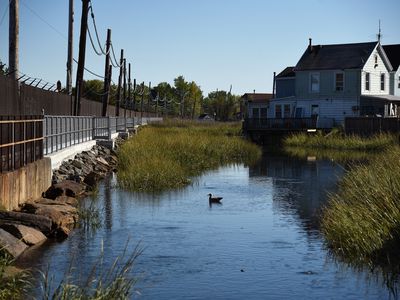
Down at the edge of Jamaica Bay, beneath the subway tracks and next to the airport, flows one of the most-seen but least-known creeks in New York City. It meanders past 100-year-old boat clubs and bungalows, travels underneath the AirTrain and the A train, and is the main reason that most of the nearby communities exist.
But to millions of visitors who look out over its waters while on their way to JFK, it has no name. And for many of the residents who live along its shoreline, its path remains a mystery, though its waters flood their streets during nearly every full moon.
This is Hawtree Creek, which passes through a pocket of New York City that feels like it belongs to a different century. Families living near this waterway still take "the boardwalk into town" like their grandparents once did, still keep a boat or two in the dock out back, and still navigate gravel roads through marshlands to get to their homes, which are built on pilings out over the water.
"We’re in the largest city in the country, really, and yet it’s like a small town," says Betty Braton, who grew up swimming and boating in the waters of Hawtree Creek during the 1950s. "We are the city we are because of the waterfront we have."
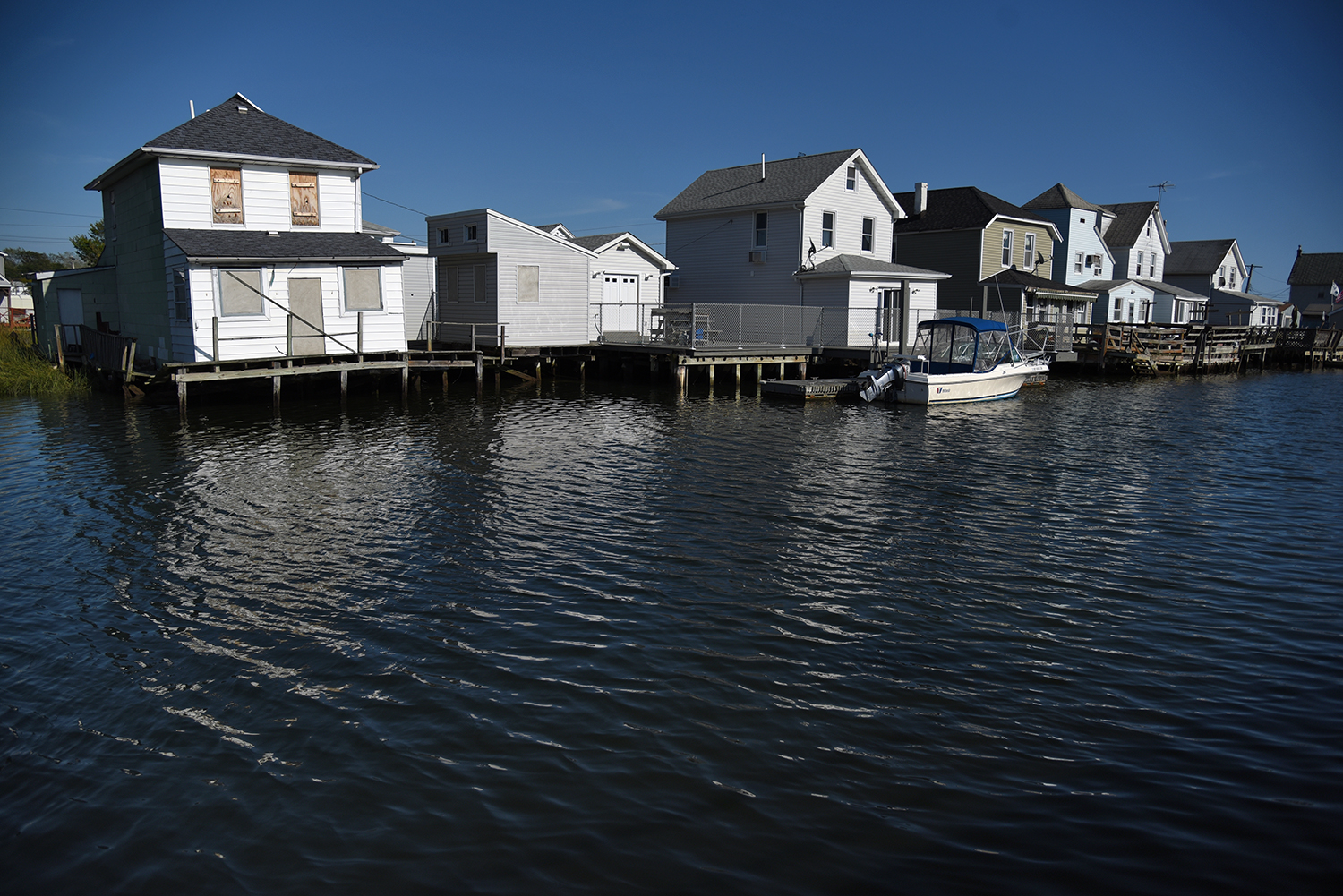
Most of Hawtree Creek’s length was filled in long ago to create residential areas, and today, it wanders aboveground through just a handful of unique Queens neighborhoods, including Hamilton Beach, Old Howard Beach, and the tiny enclave of Ramblersville, the smallest neighborhood in New York City, which is also the oldest part of this community. "That’s the origins of Howard Beach and Hamilton Beach—the original settlements were fishing communities around Hawtree Basin," says Braton, who is the chairperson of local Community Board 10. "When they were built, they were basically summer places, and then over the years, they grew into year-round communities."
We are the city we are because of the waterfront we have.
Although Hurricane Sandy washed away many of their old maps and photos, the two historic waterfront boat clubs that remain along Hawtree Creek today are still lively places to trade stories about the area’s colorful past. At Rileys Yacht Club, tales of Rat Island and Flynn Canal—two local landmarks in the club’s backyard—are traded over a friendly, private bar. Over at the Howard Beach Motor Boat Club, which was incorporated in 1916, a rollicking crowd offers up various interpretations of Hawtree Creek’s course, with some claiming it as a canal and others calling it a river. Stories of rumrunners and sunken boats are common among older residents of the community, who take an evident pride in the creek and its history.
"It was a lovely place to grow up," says Braton. "That was our playground, the water. We would go swimming, and if it floated we made a boat out of it. That was part of the joy in living in a community that was on the waterfront." The charming isolation of Hawtree Creek has largely managed to survive into the present day, and several of the streets and homes along its shoreline don’t appear to have changed all that much in the past 110 years. And though people no longer swim in its waters, according to Braton, they do fish, boat, jet ski, and catch crabs. "This was a place where the waterfront played an important role in people’s lives. Today, it still plays an important role, but kind of in a more negative way, given the ramifications of Sandy."

Like Broad Channel Island, Edgemere, Meadowmere, and other waterfront communities situated along the edge of Jamaica Bay, the neighborhoods along Hawtree Creek are sitting at the frontlines of climate change in New York City. During Hurricane Sandy, a huge storm surge pushed up the creek, flooding practically every home in the area. Eight feet of water swamped the Howard Beach Boat Club, and the water almost reached the second floor windows near Coleman Square, at the head of the creek. For a community so intertwined with the water, the challenges ahead are self-evident.
"My constituents are extremely worried about flooding," says New York state senator Joseph Addabbo Jr., who represents Senate District 15. "They still want to remain on the waterfront, but they are very aware of not only high tide and surge, but also of the next storm that may come about." Hurricane Sandy resulted in major damage throughout the area, but even "sunny-day flooding" can lead to serious problems, something that Senator Addabbo knows well. His offices are located just a block away from Hawtree Creek, near streets that flood regularly during high tides. On a recent afternoon, a manhole cover had been left propped open nearby, allowing a waterfall of saltwater to return to creek and flow back out to the bay.

"I understand it because I witness it myself," says Addabbo, whose staff is often unable to get to work because of flooded streets. "We frequently deal with the high tide." Regular tidal surges have ruined cars, swamped basements, and caused a number of other headaches for local residents, who have implemented a variety of small-scale solutions to combat the problem, from bulkheads and berms to raising houses up above flood level. Still, the waters keep pouring in, and the situation has only gotten worse over the years.
"There are some pockets that flood every time the moon is full," says Braton, who has seen a significant increase in flooding over the last 70 years. "There are times when you have to know the tide cycle, because you would not be able to walk across the street without walking through a foot and a half of water."
And yet, since Hurricane Sandy, no major new storm mitigation projects have been completed here. "We are now four years removed from Sandy, and we are still in the planning stages of most of these projects," says Addabbo, who has been working to cut through the governmental red tape. "The bigger projects, which should certainly stop flooding and protect the shoreline, are years away."
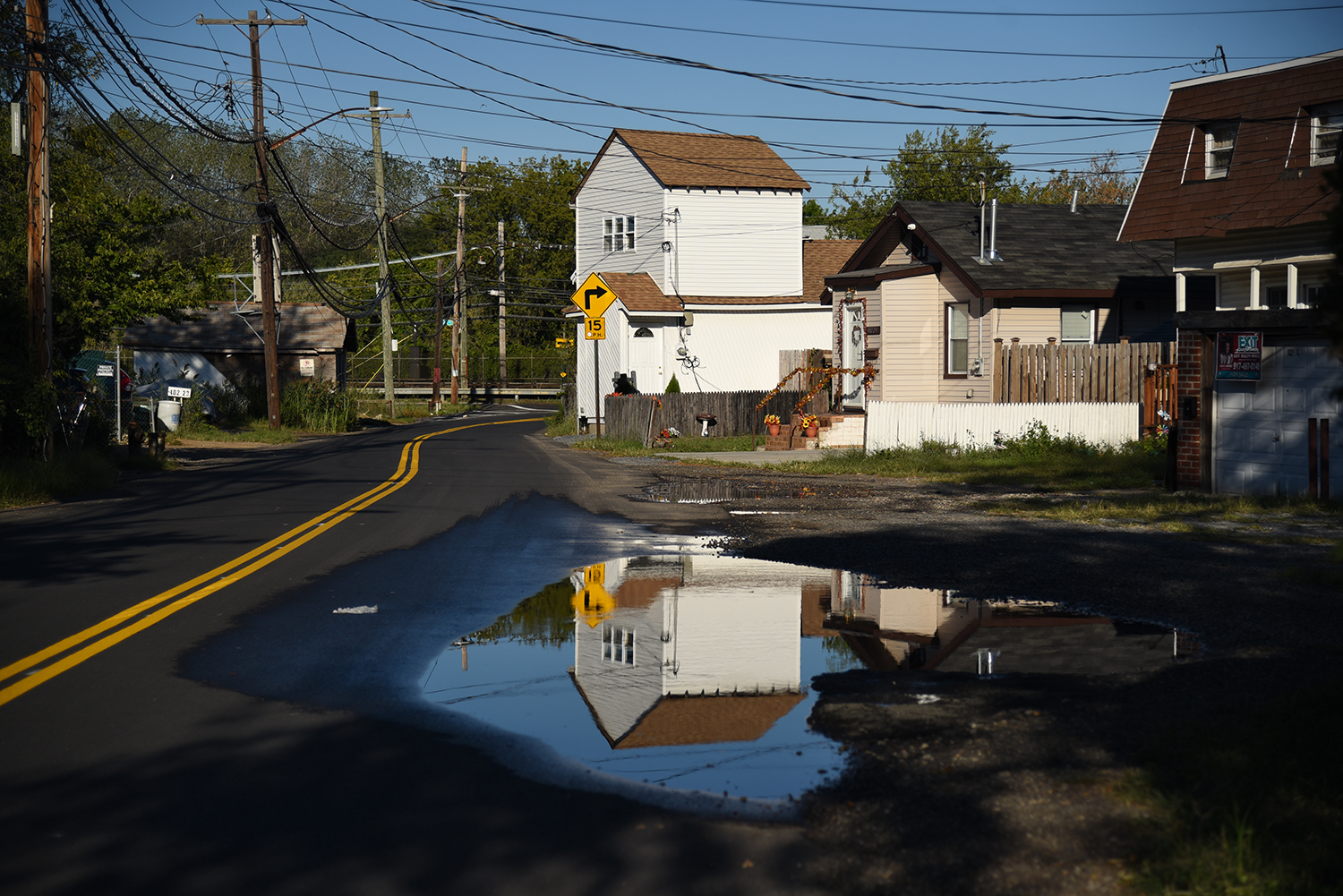
In the future, the landscape around Hawtree Creek and Jamaica Bay will be radically different. As sea levels continue to rise, and as the bay’s salt marshes continue to be threatened by pollution and erosion, drastic solutions are being considered to protect both residents and nature. "I think the largest idea is a gate that they are looking to do along Jamaica Bay, that would stop any kind of major surge," says Addabbo, referencing a recently announced set of proposals by the US Army Corps of Engineers (USACE). "That is a huge endeavor, putting up a gate like that, which basically opens and closes based on the storm."
The proposal that the USACE seems to be leaning towards is Storm Surge Barrier Plan C-1E, which would place an enormous gate across the mouth of Jamaica Bay, just east of the Marine Parkway Bridge. This structure would include seven 100-foot vertical lift gates and two 200-foot sector gates, and would permanently impact 130 acres of habitat around the bay, from maritime forests to intertidal mudflats.
We are four years removed from Sandy, and we are still in the planning stages of most of these storm mitigation projects.
The USACE has also put forward an alternative approach, named the Jamaica Bay Perimeter Plan, which would build 13 smaller flood gates at the mouth of each tributary on the bay, including Hawtree Basin. No matter which proposal is adopted, the scale of these projects would be staggering, both in expense and physical size.
"We may not live long enough to see any of them built," says Braton. "But the main barrier, combined with smaller barriers, would solve, to a great extent, a lot of the flooding problem." And despite the looming specter of larger storms and more frequent floods, there has not been an exodus among those living around Hawtree Creek.
"This area is a little different than other areas of the city," says Addabbo. "Most of the residents have been here for generations. And they want to be near their community. They didn’t want to run after Irene or Sandy, they worked hard at staying here … But they know they have to deal with issues of water quite frequently."

The mouth of Hawtree Creek is located on the northern shoreline of Jamaica Bay, between the Joseph P. Addabbo Memorial Bridge and the MTA’s North Channel Bridge, looking out onto Broad Channel Island.
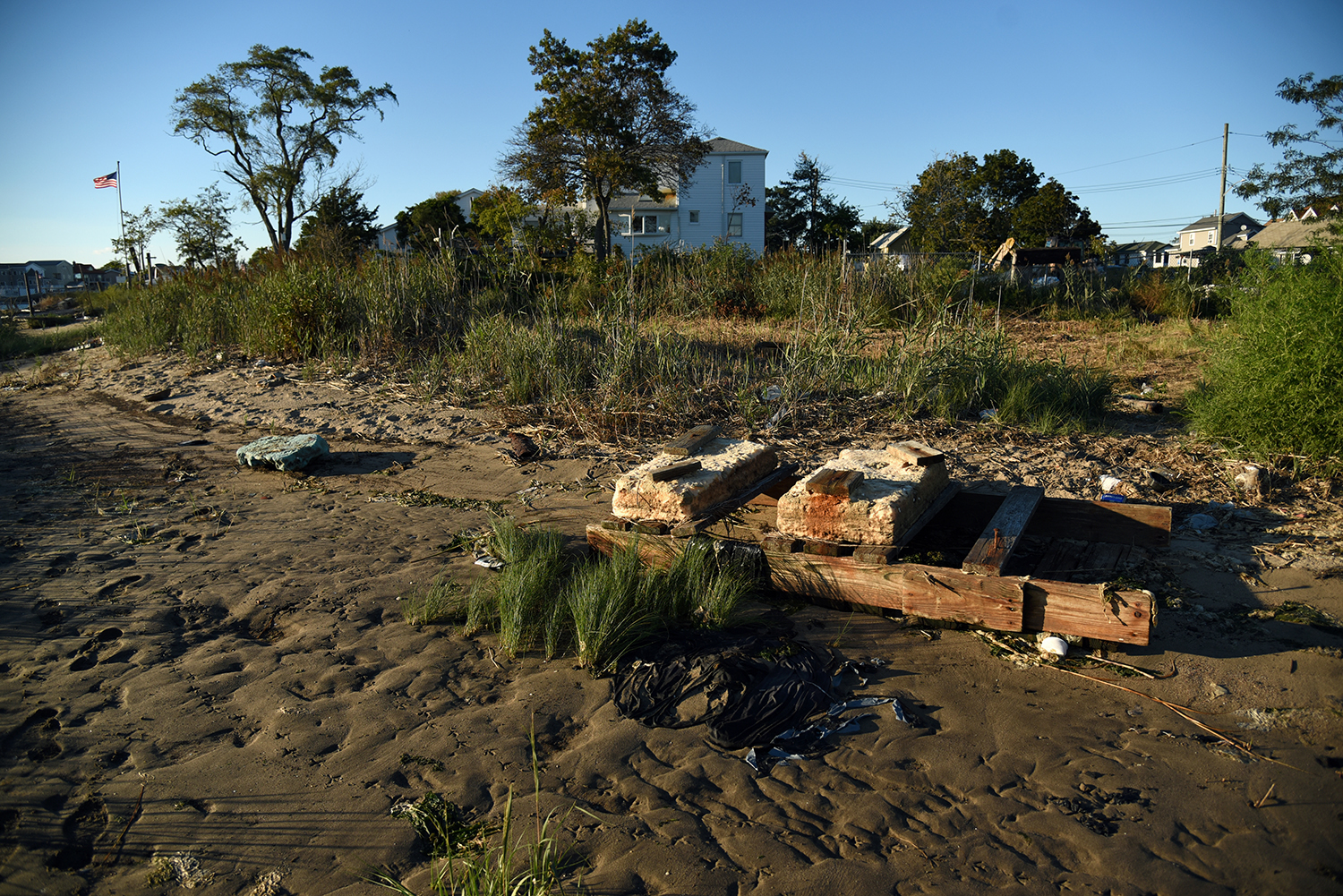
The shoreline here, on both sides of the creek, is part of the Gateway National Recreation Area, and is bordered by the several homes at water’s edge.
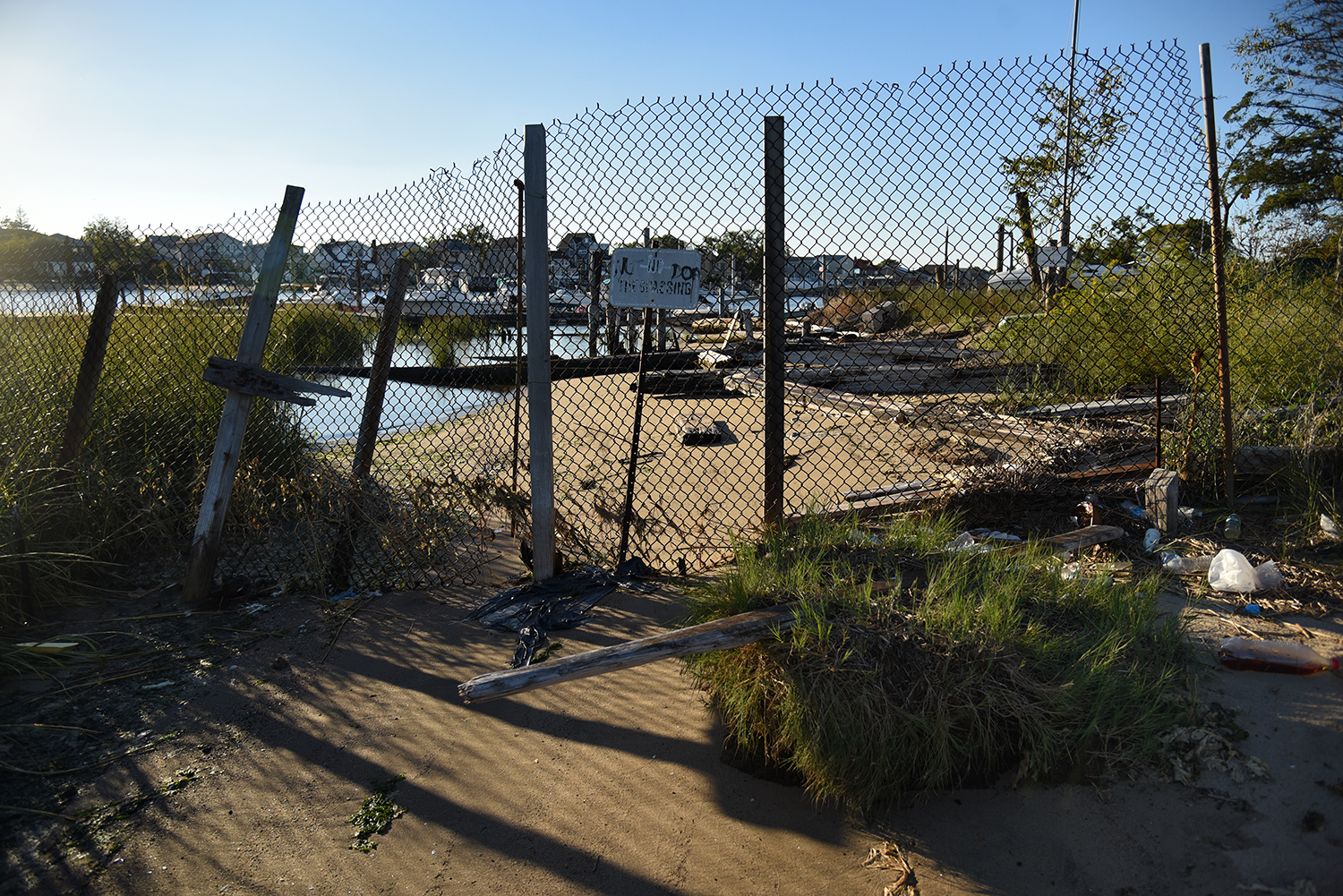
The first glimpse of Hawtree Creek, on the Hamilton Beach side of the waterway, is through a chainlink fence, blocking off access to a local dock. Much of the creek’s shoreline is inaccessible, and lined by private homes and piers.
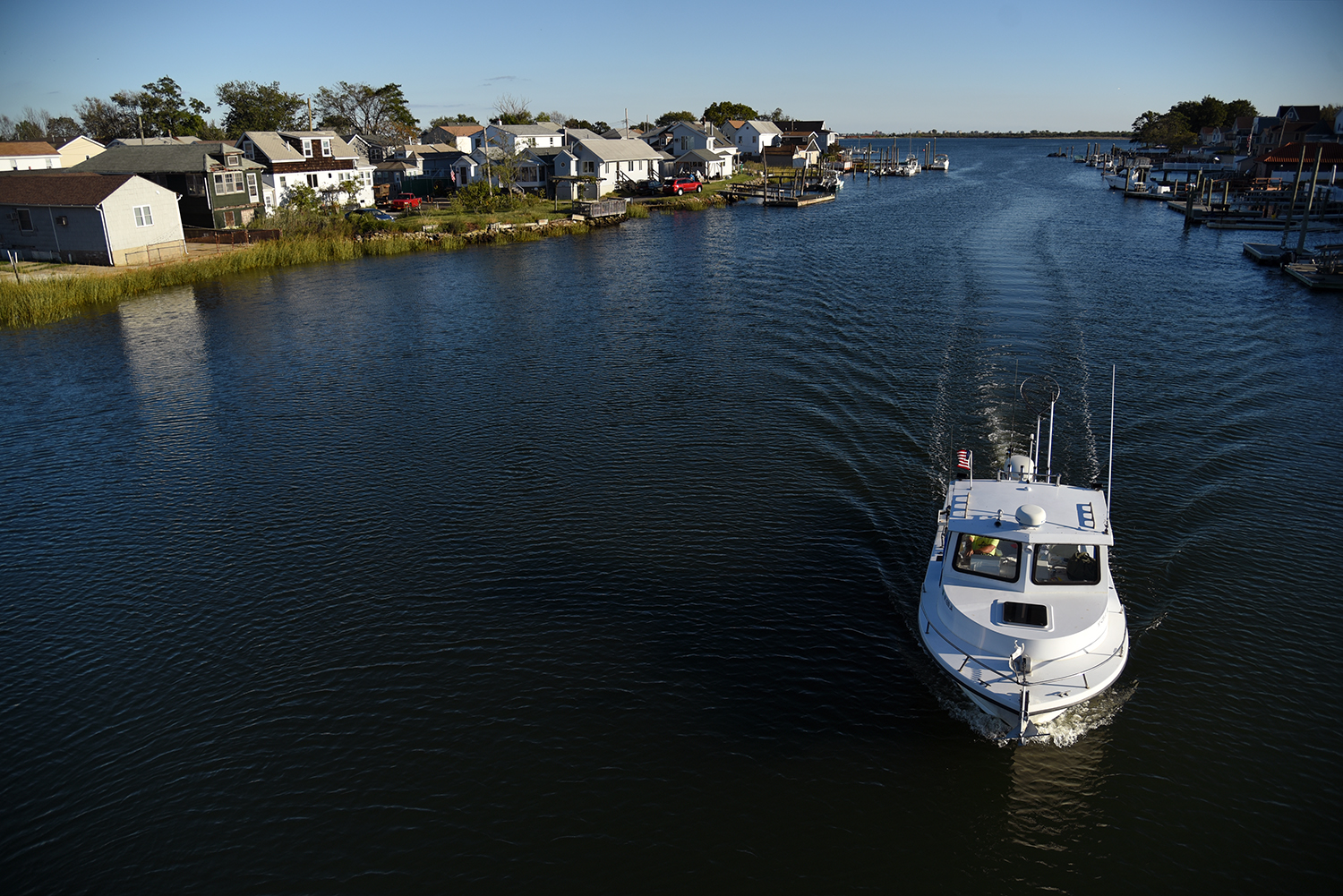
The creek was widened in the early 1900s to help create the Hawtree Basin, a canal used by fishing boats, though its history is much older. "Hawtree Creek meandered northeasterly for centuries before the first fishermen's squatter shacks were built upon its banks in the years after the Civil War," according to a history published at the Howard Beach Motor Boat Club website.
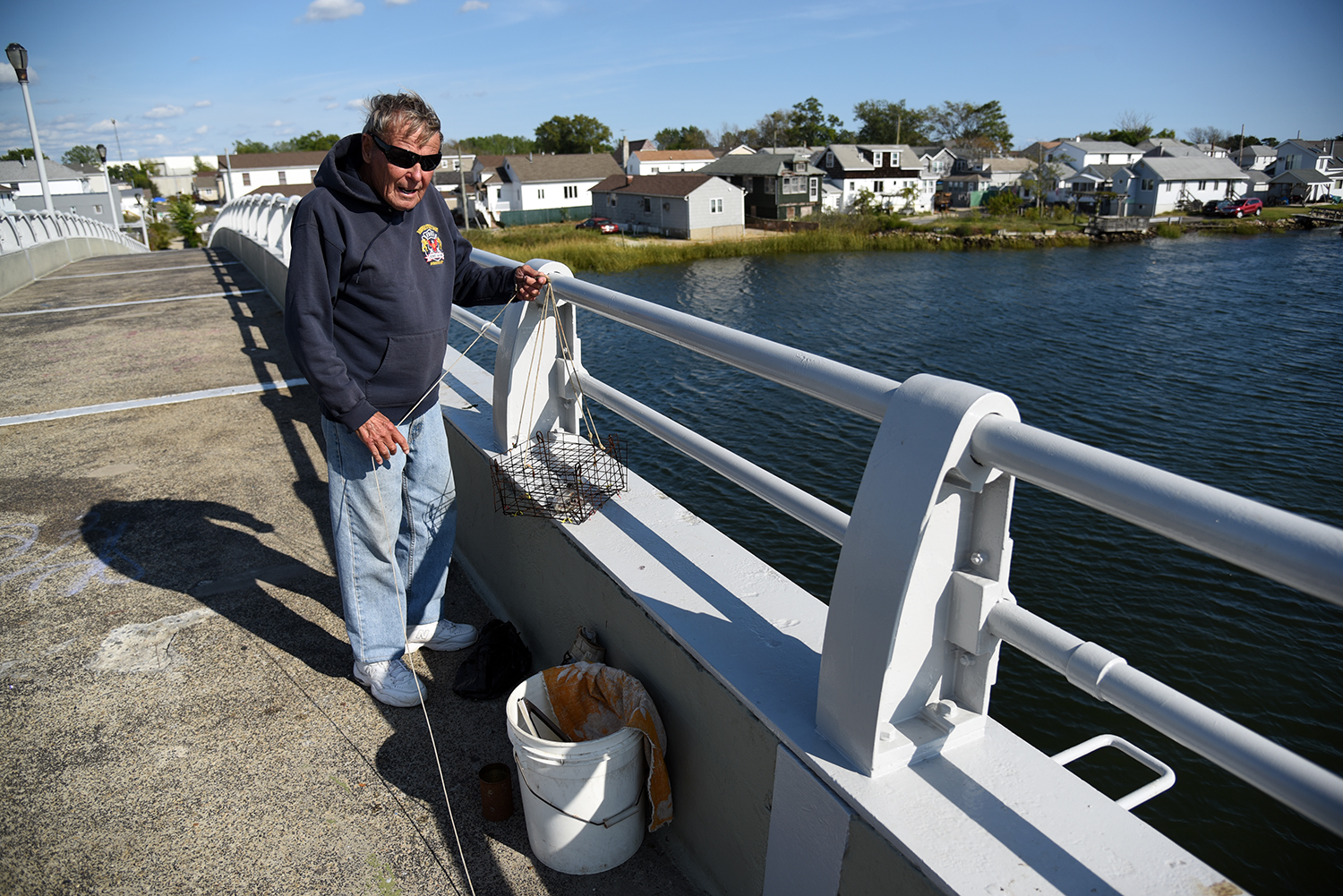
The Hawtree Basin Bridge, a pedestrian overpass connecting Hamilton Beach and Howard Beach, is a popular spot for fishermen and crabbers. "I’ve been doing this probably 30 years," says Charlie Kirchner, a retired fireman. "I’ve caught a lot of crabs—ate a lot, too."

Kirchner’s bait is bunker, a common fish in this saltwater estuary. "I don’t know of any freshwater feed here," says Kirchner. "This is all saltwater from the bay."
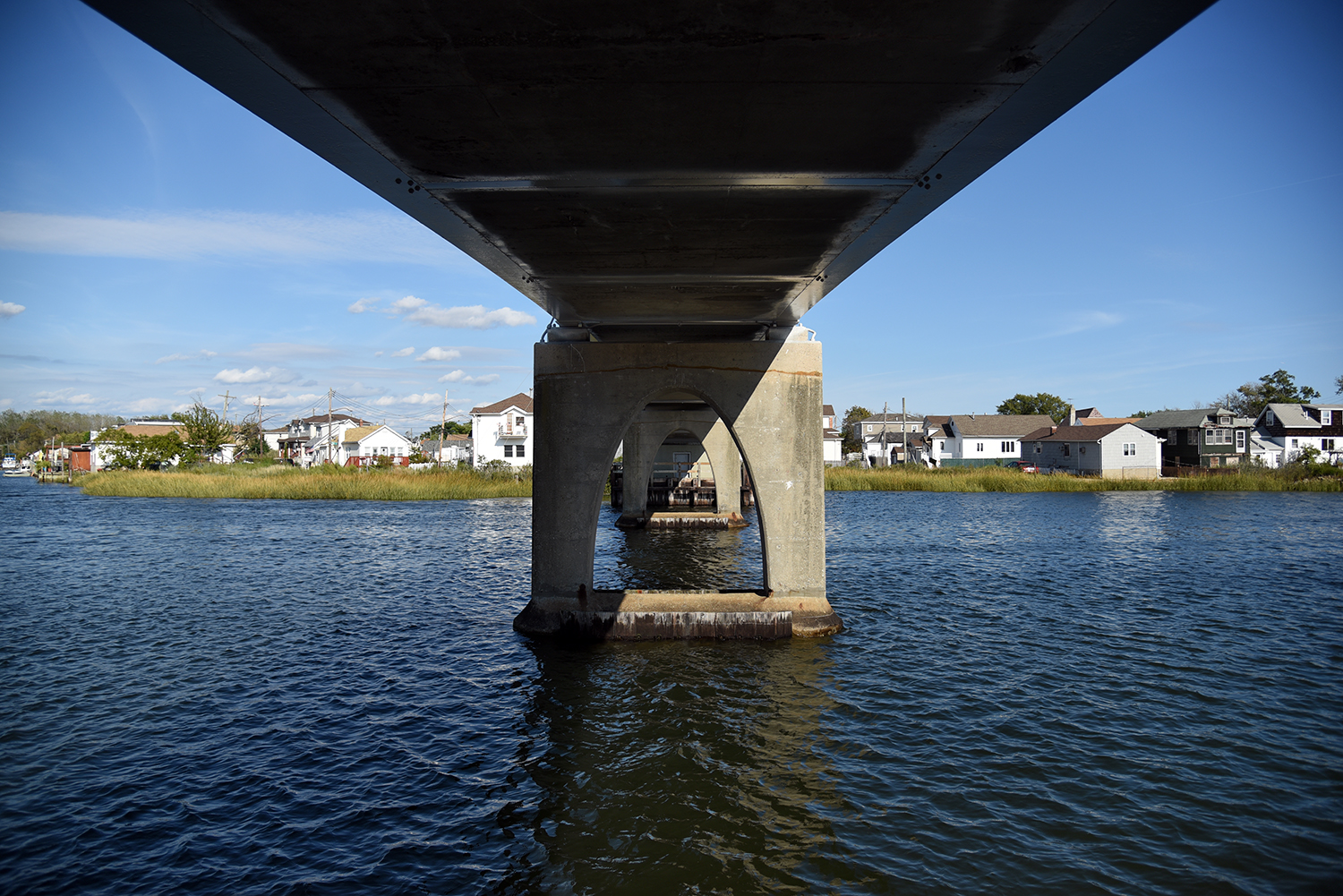
Underneath the bridge is one of the rare public access points to the creek’s waters. "Just at high tide, the water is sometimes three or four houses in, here," says Kirchner. "These communities are very temporary, in the eons of time."
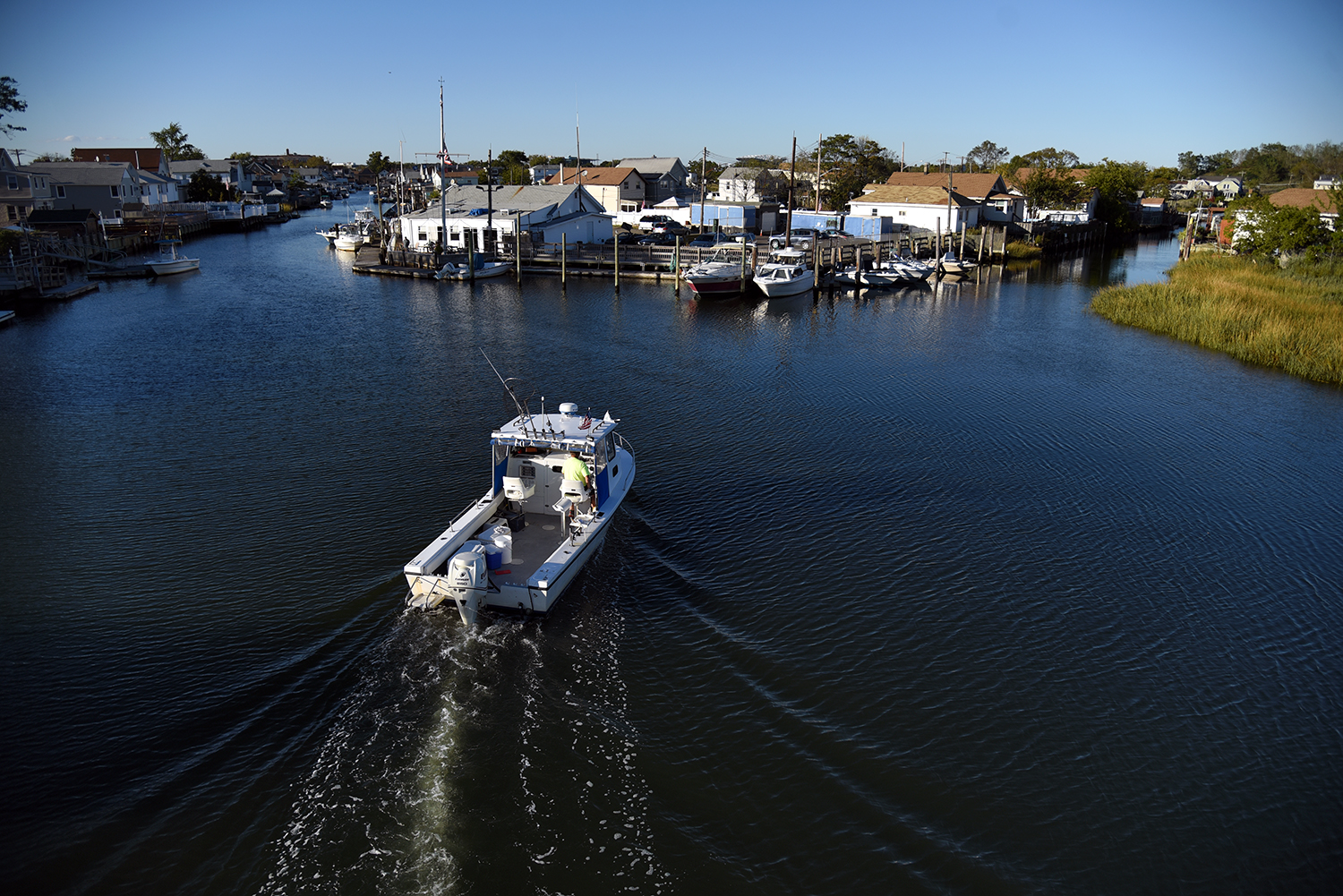
Looking north from the bridge, the path of the creek splits into three directions. To the east is Flynn Canal and Rileys Yacht Club, and to the west, the creek passes the Howard Beach Motor Boat Club before splitting in two. "We had eight feet of water here during Sandy. Fuhgeddaboudit. We had to repair the whole building," said one motor boat club member.
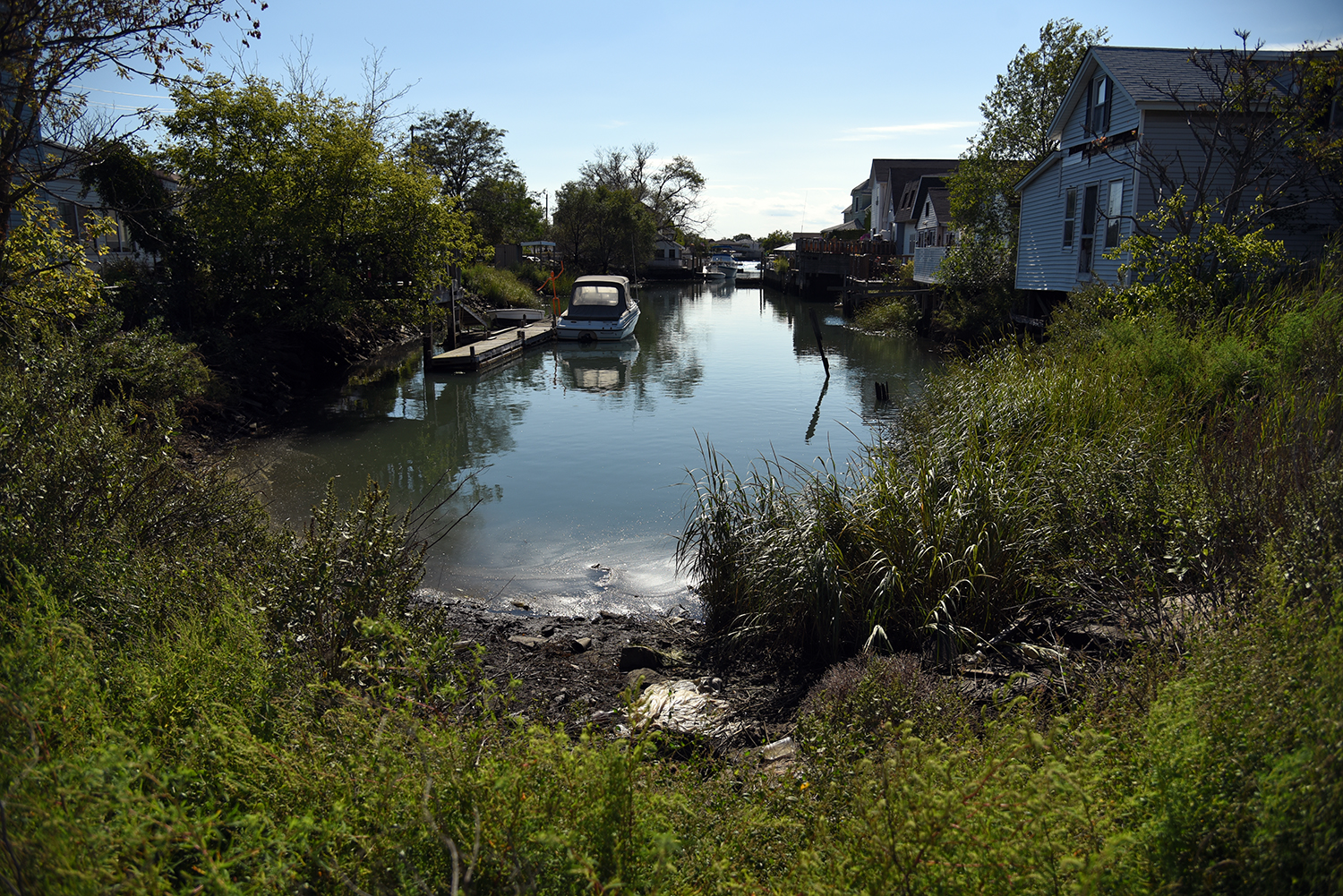
Flynn Canal, as some locals call it, is an offshoot of the creek that flows past Rat Island. "We see water rats and raccoons here," says one member of Rileys Yacht Club, which looks out over the island and canal. As the tide changes, water at the head of the canal almost reaches the sidewalk along Russell Street.
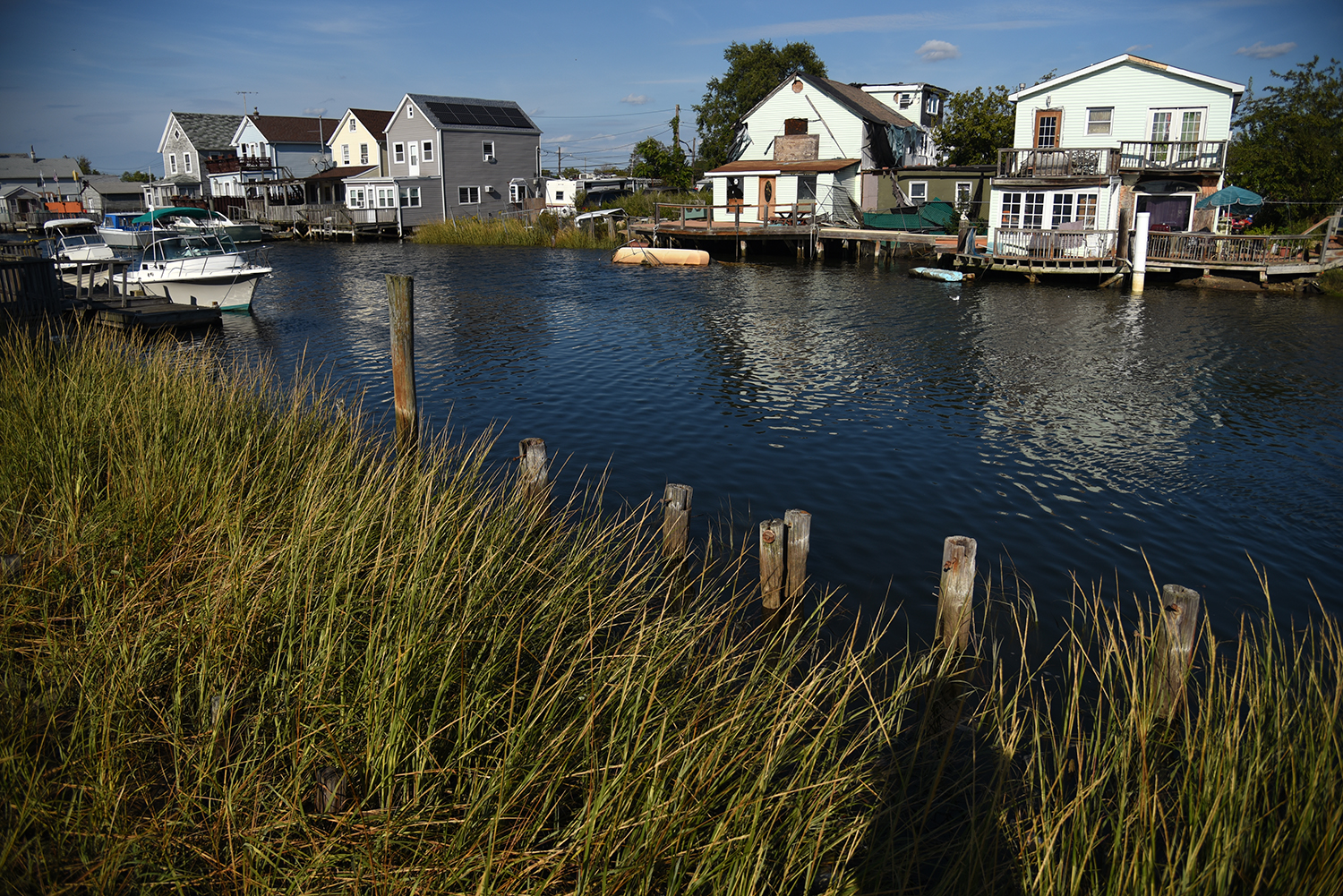
On the Hawtree Basin branch of the creek, the older homes of Ramblersville look out towards Howard Beach. In some ways, this area has not changed much in the last century. "By the 1890s it was known as ‘Little Venice,’ a summer and weekend resort community which by then had year-round residences," according to the Howard Beach Motor Boat Club website.

In Ramblersville, fire hydrants are sunk into the marshland, or placed on gravel roads, and the boardwalk passes over the spartina. This undeveloped section of the peninsula is surrounded by Hawtree Creek’s waters on three sides.

Most of the homes here have boardwalks out front, each maintained in its own style by the property owner, and a boat in the backyard. Originally, almost all of the buildings along the creek were private boat clubs, with names like Frolic Fishing Club and Idle Hours Boat Club.
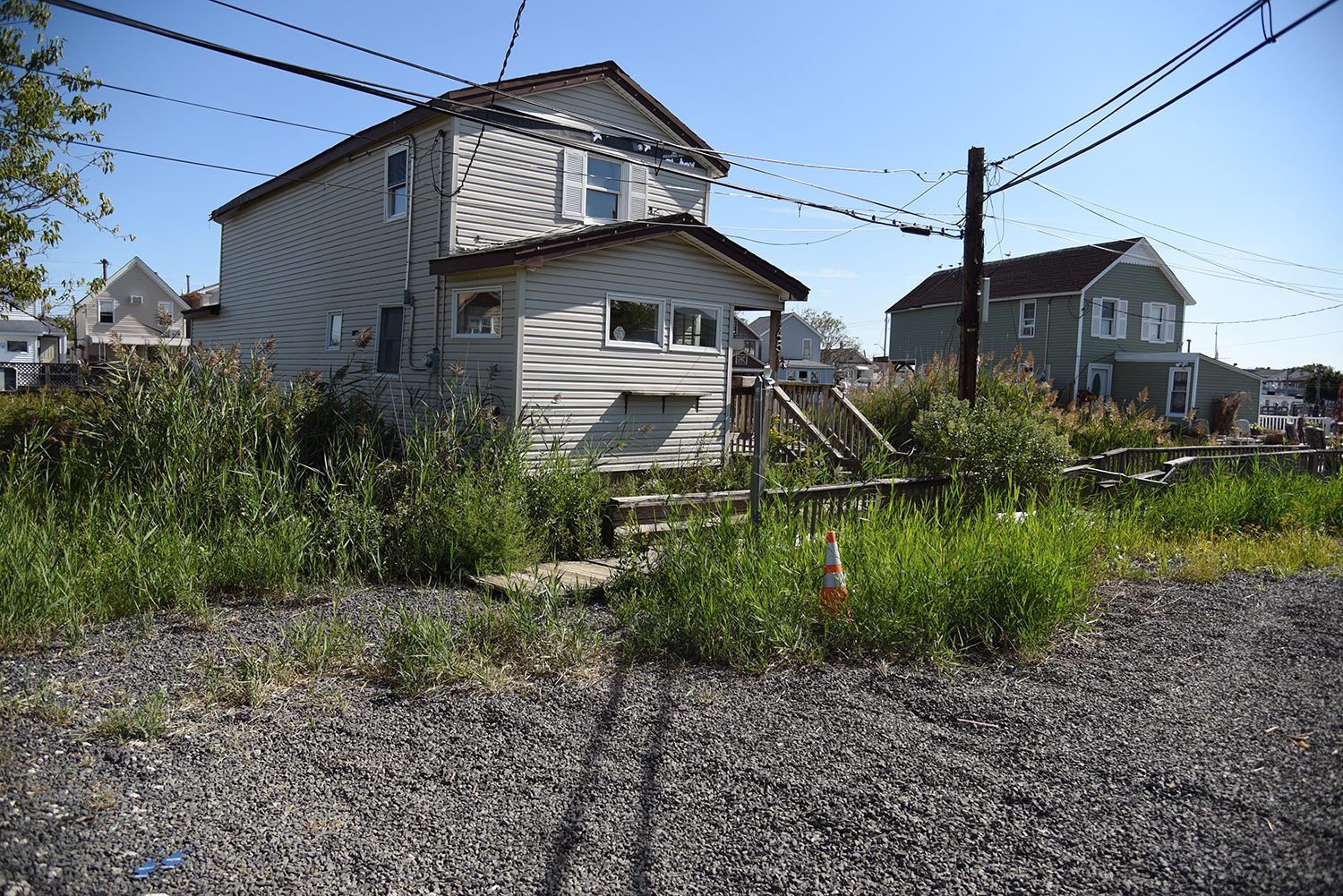
Gravel roads are not uncommon in this section of Hawtree Creek, though boardwalks and boats were once the only form of access. "In 1899 the Long Island Rail Road added a stop at Ramblersville. There was no station; the train simply stopped at Russell Street and the passengers disembarked. If the tide was high they stepped from the train into a foot of sea water," according to the Howard Beach Motor Boat Club website.
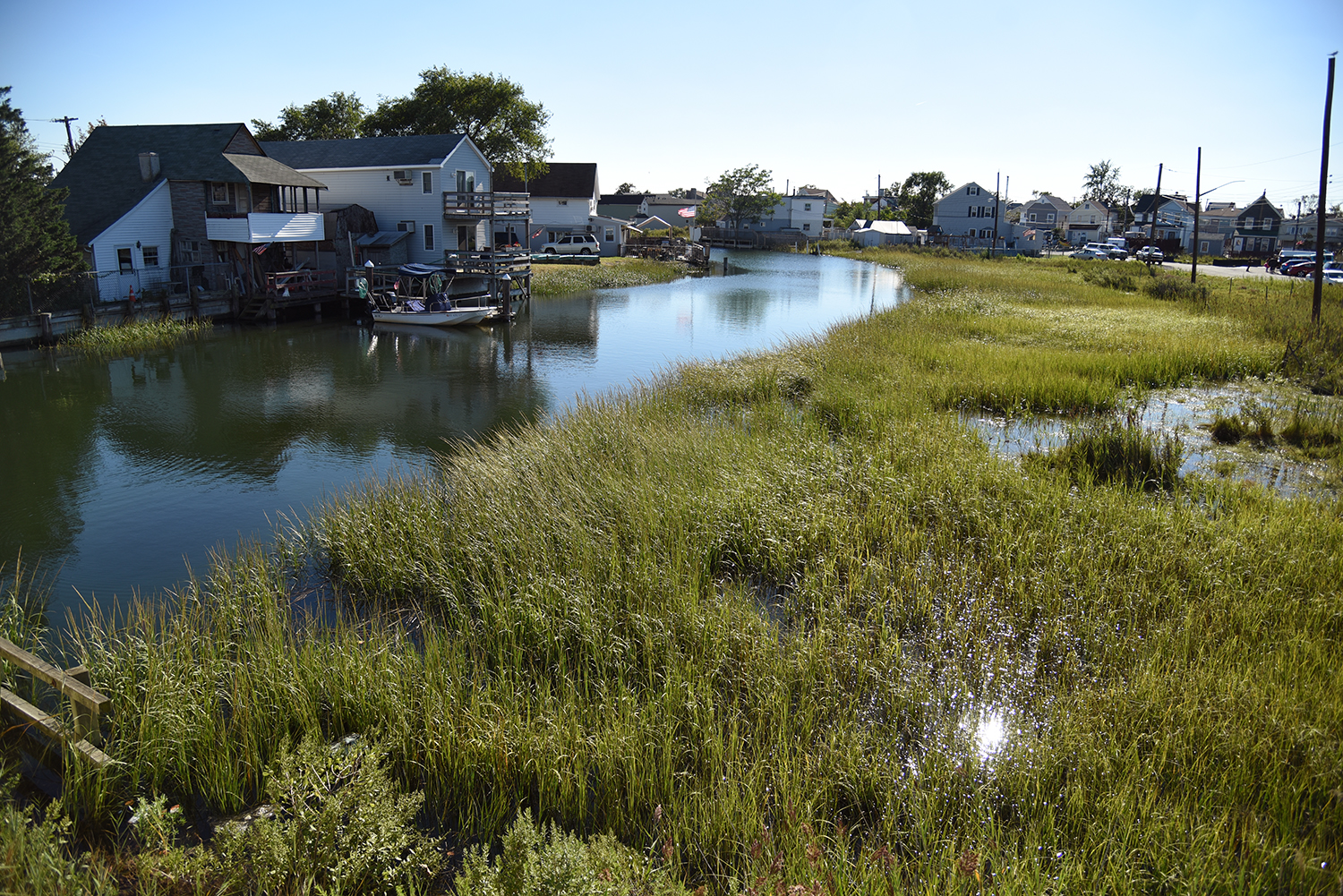
As the creek continues inland, it cuts between Ramblersville and Hamilton Beach, through another section of undeveloped marshland. "When I was a kid, if you found a sunken rowboat somewhere, if you could get it to float, that was an afternoon’s escape," remembers Braton. "We built rafts out of all kinds of things. If it could float, we made a boat out of it!"
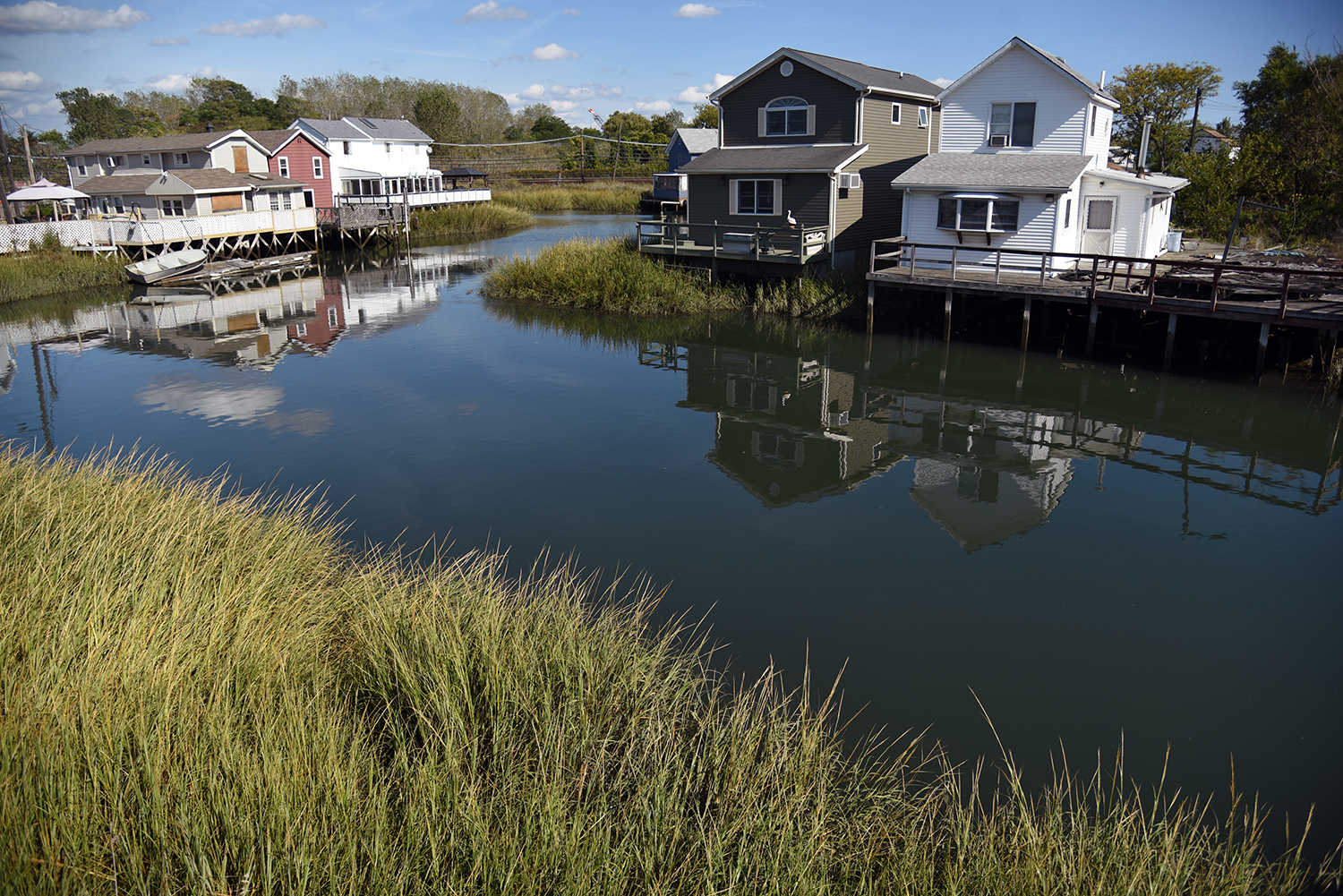
Looking out from the Ramblersville-Hawtree Memorial Bridge. A number of the houses here are built on pilings sunk into the marshland. "Those homes there date back, many of them, to the 1920s," says Braton.
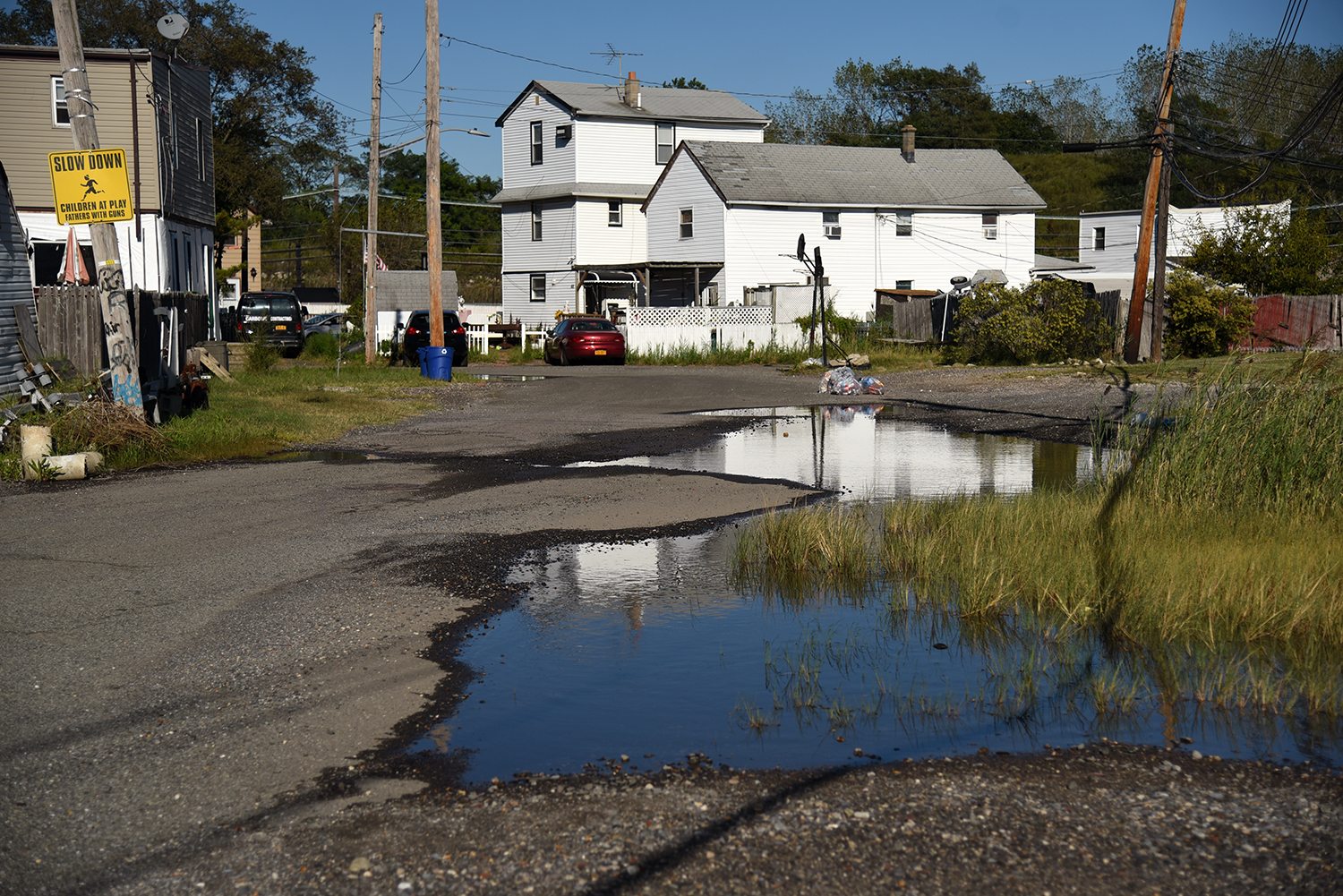
The streets in this area flood frequently, according to neighbors. "It happens all the time, like every two weeks. You get used to it," says one local resident. "This is nothing - at high tide, it comes up into the front yard."

As the creek continues through these waterfront residential areas, it also supports a number of marshland areas, where birds and fish have found refuge.

The old boardwalk into town, which is now a 2,000 foot concrete path. During a visit to the area in 2000, Kevin Walsh at Forgotten New York described the original wooden boardwalk as rickety, precarious and treacherous, and noted that it was replaced with concrete in 2003. Another renovation was done in 2015.
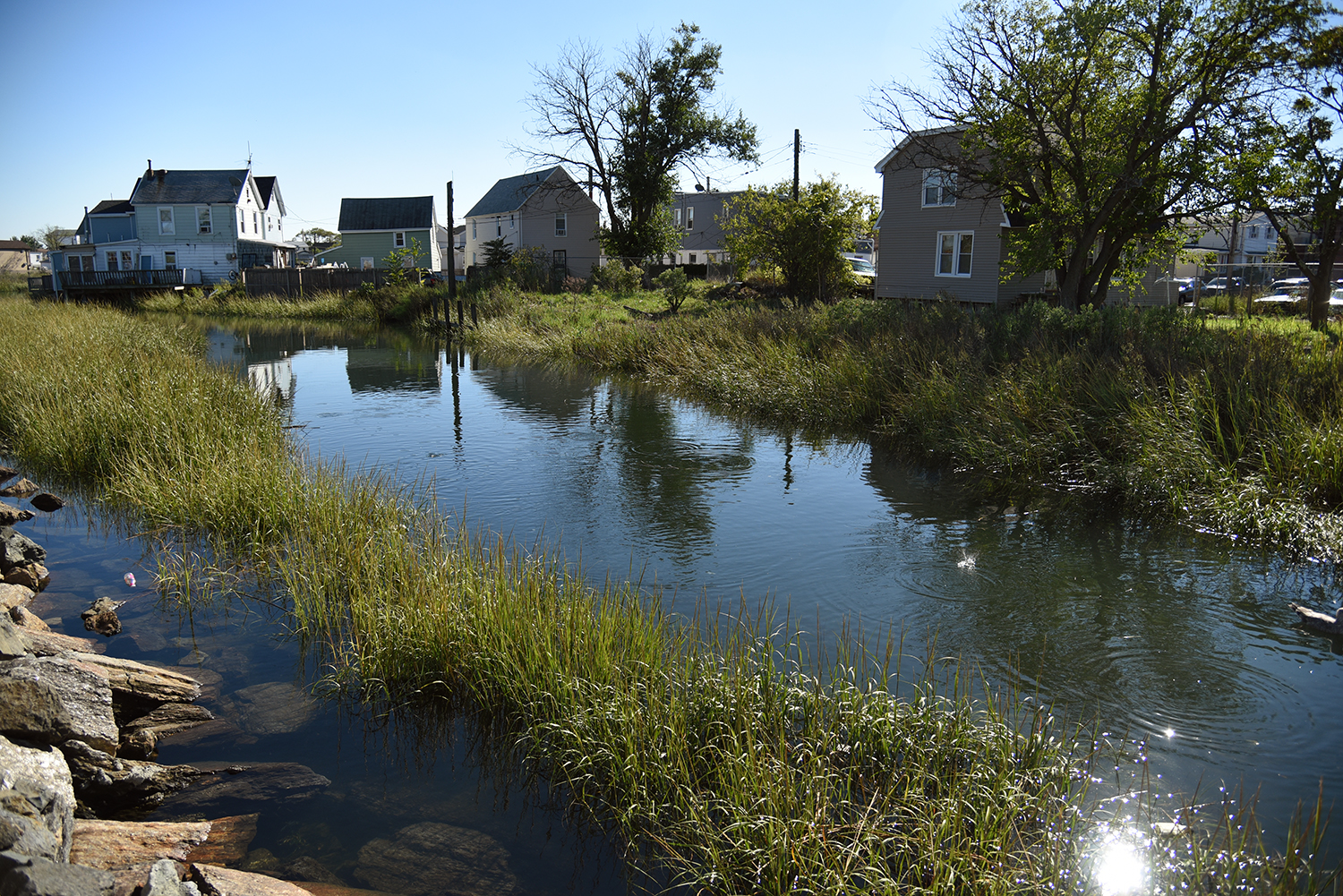
From the boardwalk, a bucolic view of Hawtree Creek, as it flows past several isolated country homes. If not for the A train immediately adjacent to the walkway, this would feel like a rural backwater.

Enormous schools of fish swirl in this shallower part of the creek. "We call them peanut bunker, or baby bunker," said Kirchner. "I think their technical name is menhaden."

The menhaden gather at a culvert where Hawtree Creek travels underground, beneath the MTA train tracks. Abandoned boats and debris clog the creek’s flow here, which changes direction depending on the tide.
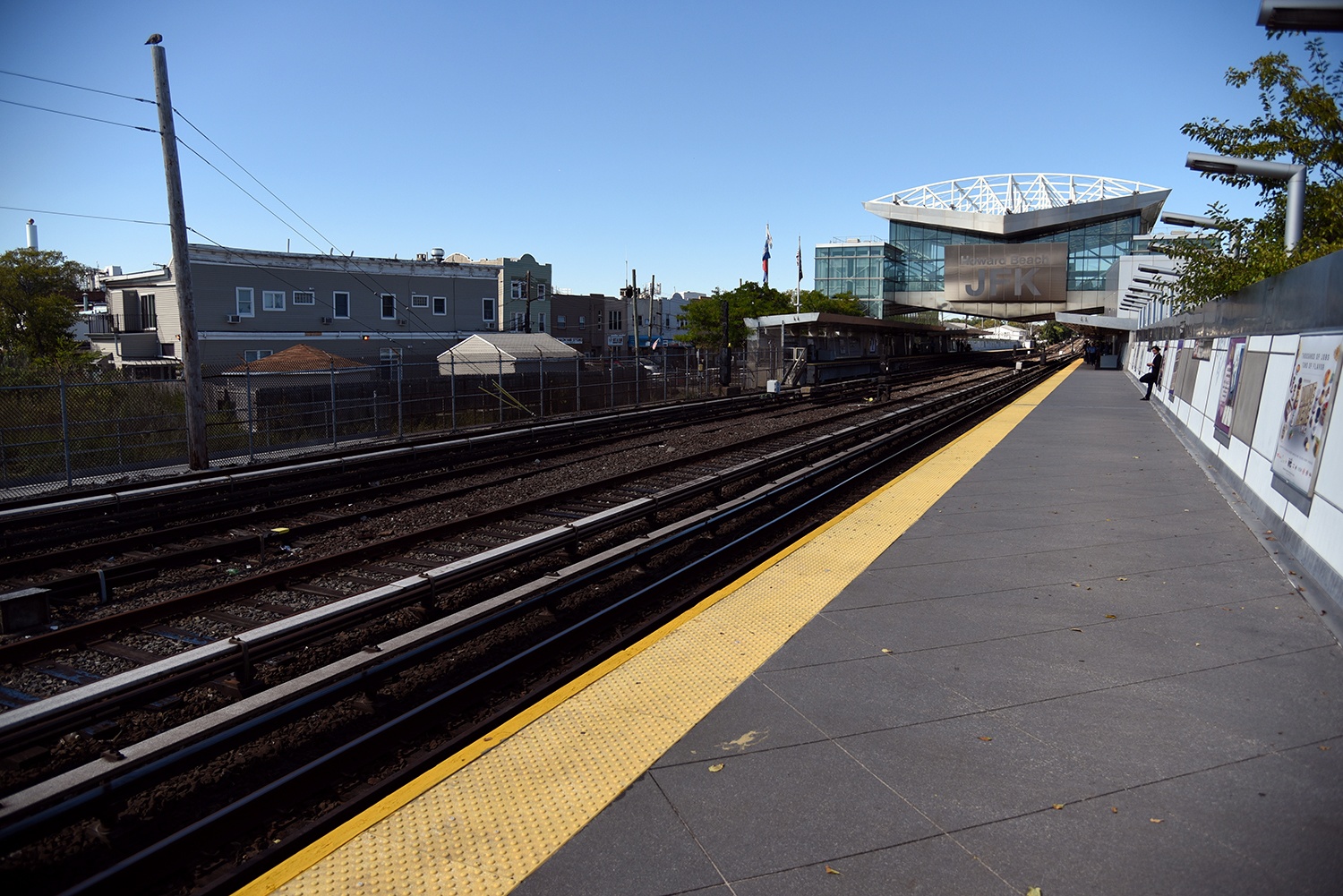
The creek passes underneath the Howard Beach train station, which was originally the Ramblersville train stop. Today it is a transfer point to the AirTrain, providing access to JFK Airport.

The glassy new station looks out over a section of the creek that is largely off limits to the public, surrounded by train tracks, train stations, and long term parking lots.
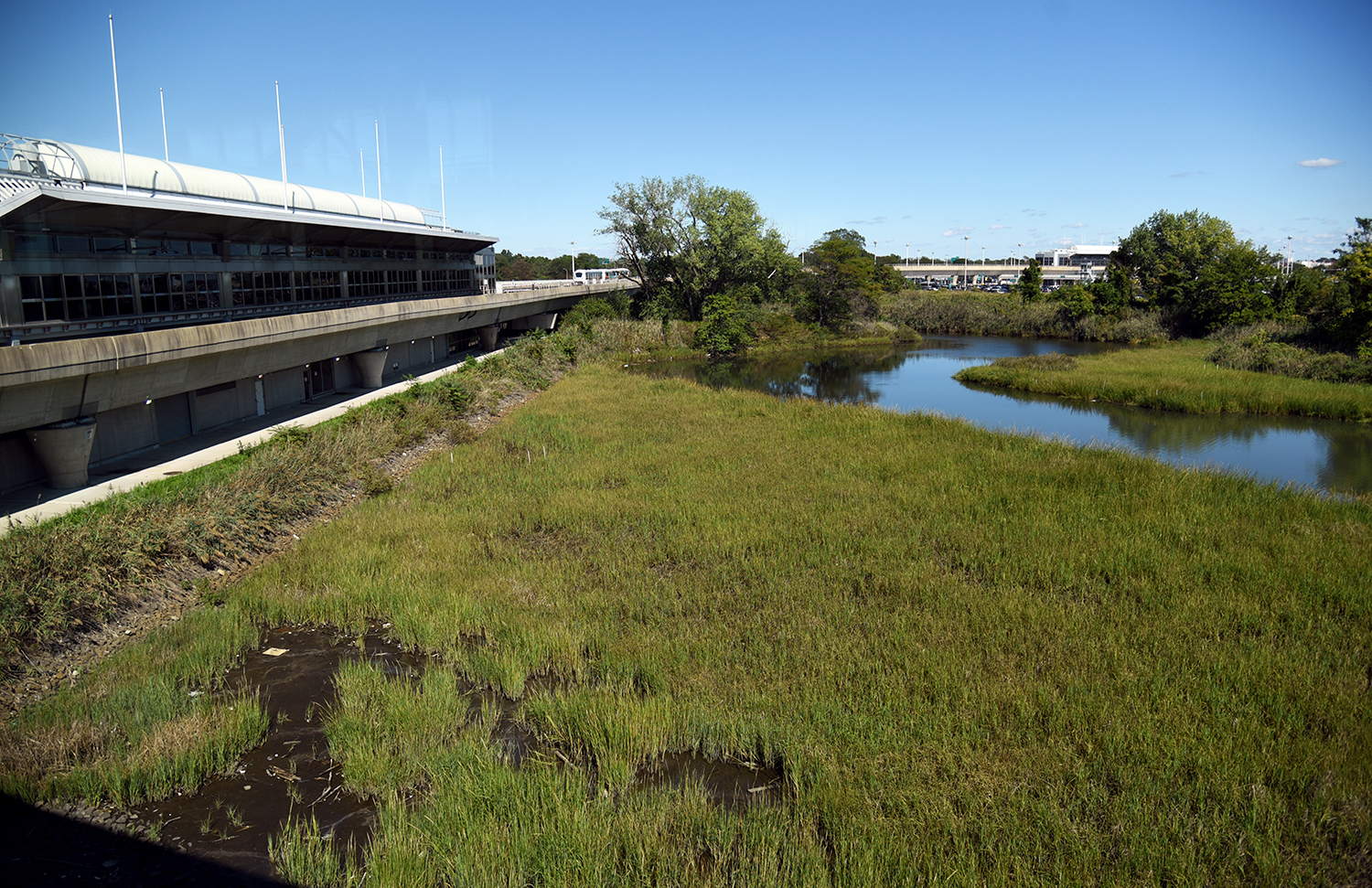
For many visitors to New York City, this station provides the only view of the creek they will have. This section of the creek is also a haven for birds and fish.

As seen from the AirTrain, Hawtree Creek is quite wide here, perhaps because it serves as the drainage and runoff area for a large part of JFK Airport.
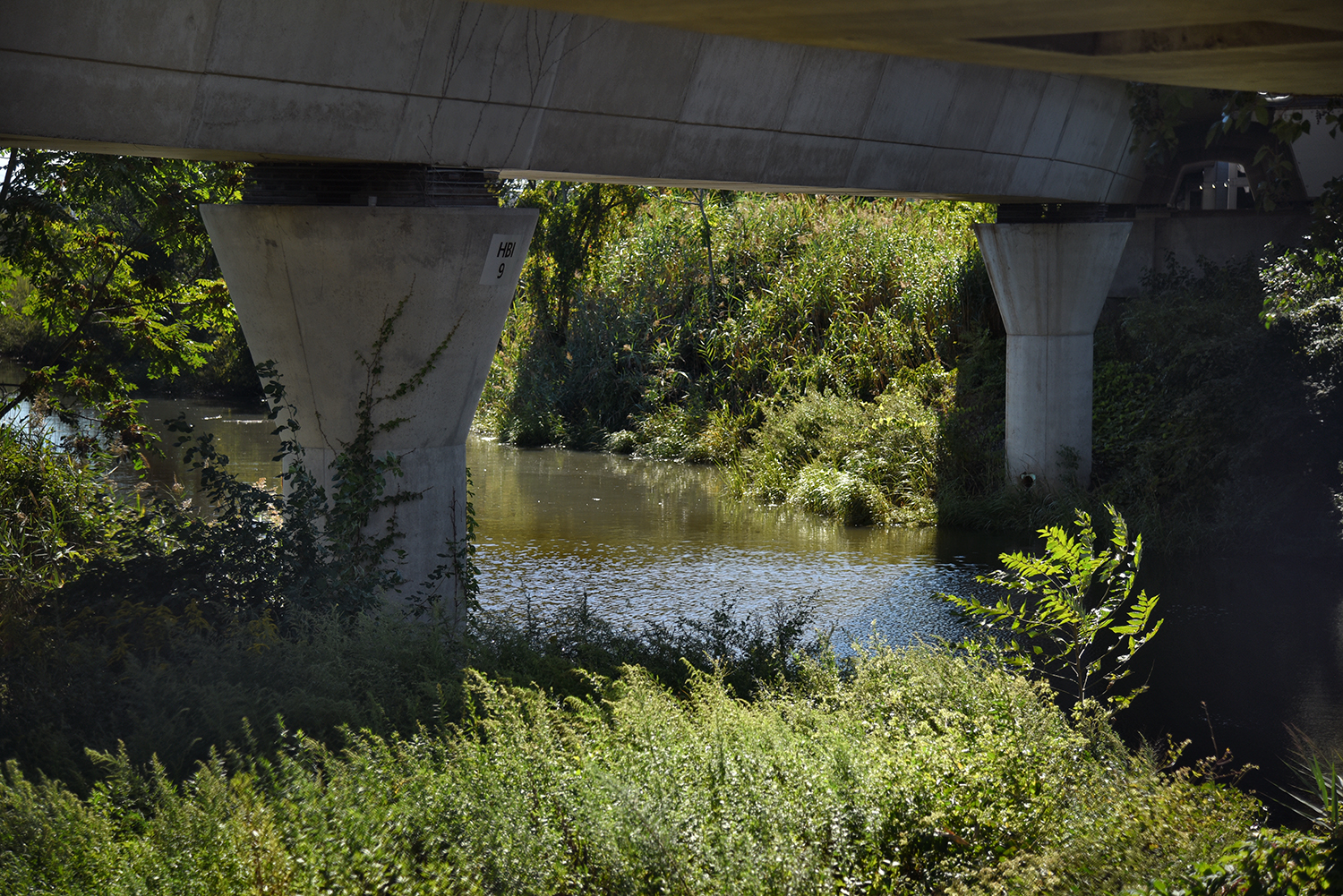
Flowing underneath the stanchions of the AirTrain, the creek is better known to the Port Authority as Drainage Area A, which "covers approximately three percent (160 acres) of the airport drainage area," according to a 2009 report.
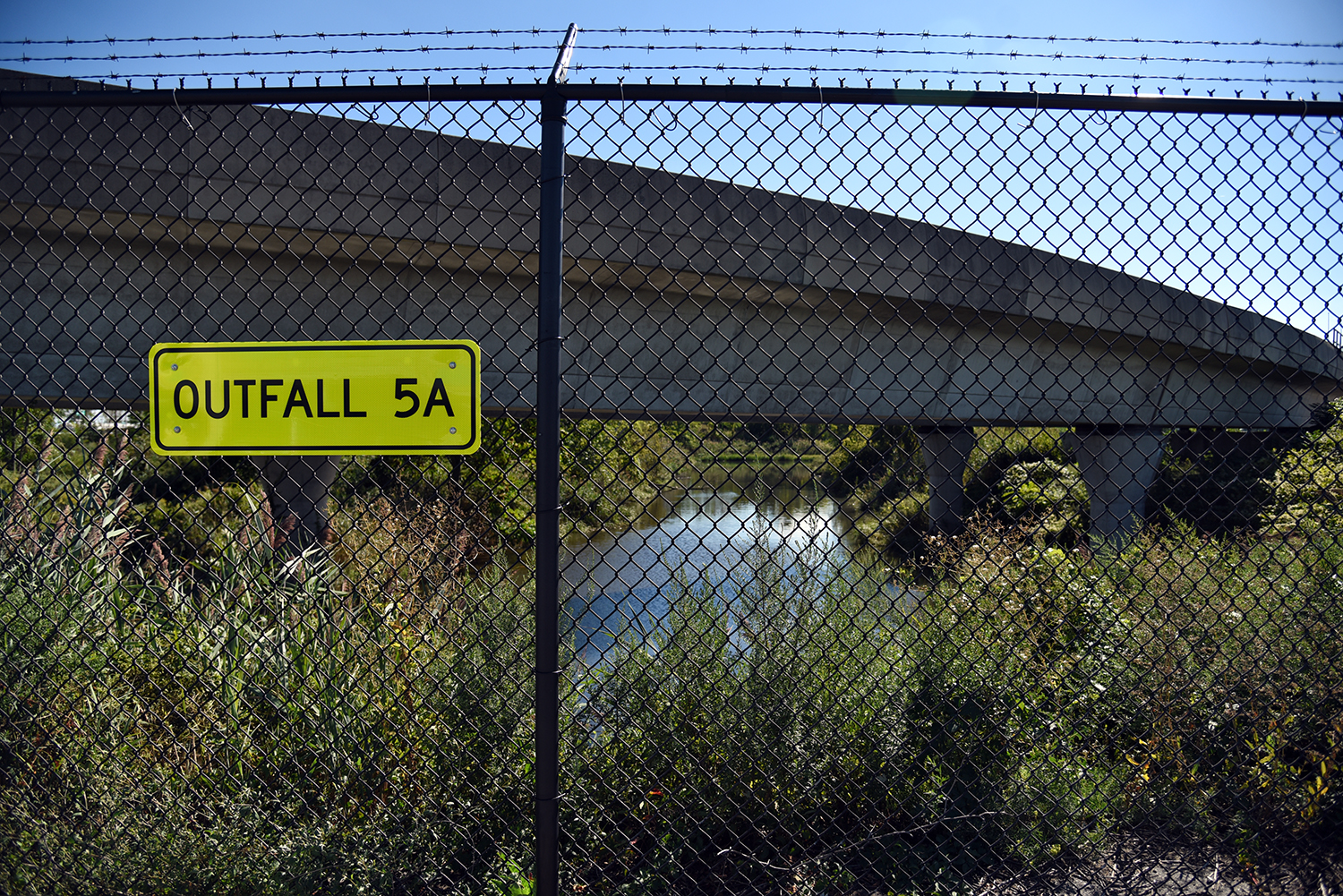
Numerous outfalls discharge into the creek here, from a surrounding area of long term parking lots. This is the last aboveground view of the creek, before it disappears beneath a field of concrete.

Despite efforts to control runoff, these parking areas have several large pools of standing water, perhaps tracing out the original path of the creek.
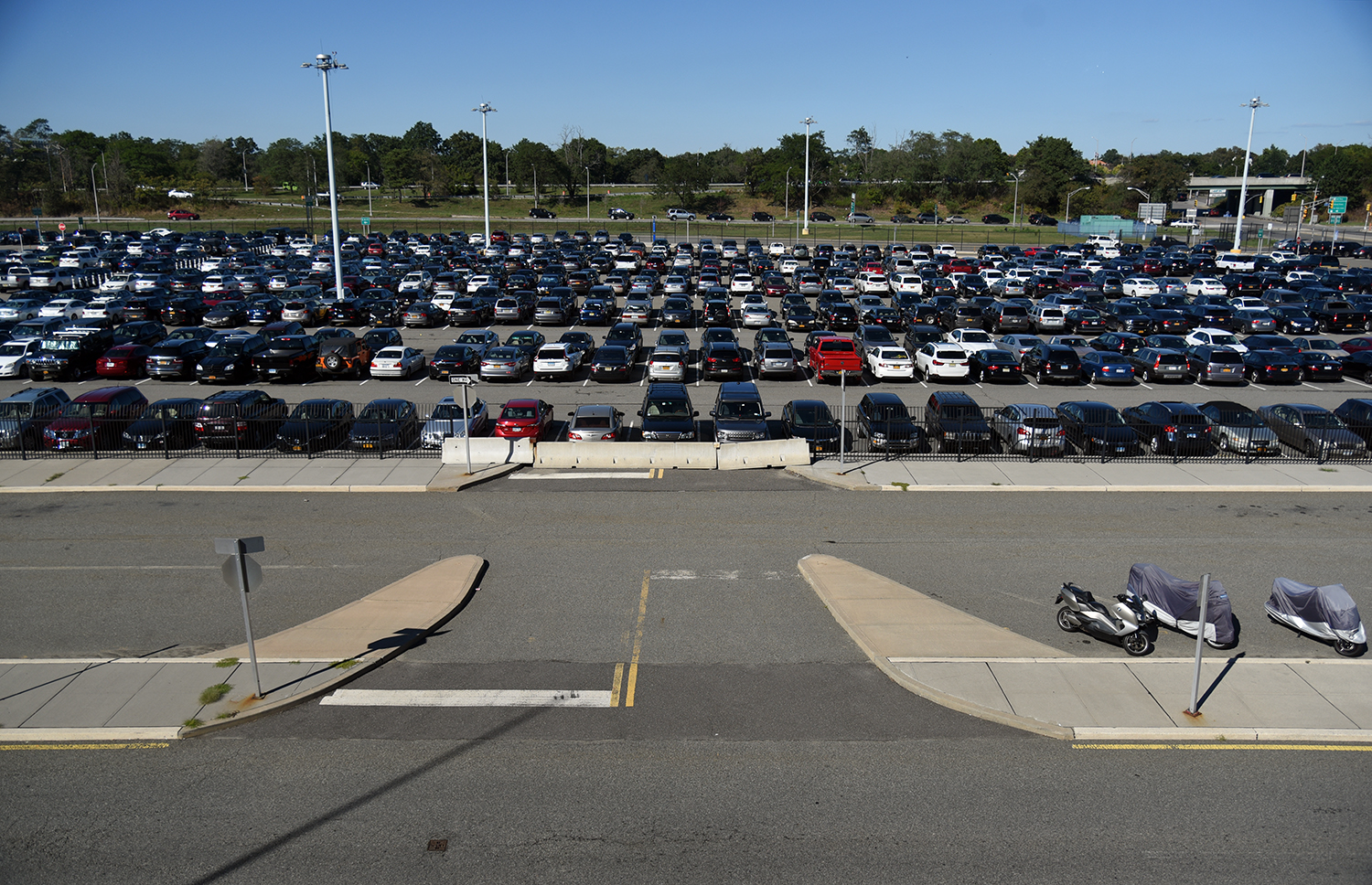
Hawtree Creek once flowed much further inland, but has been buried under highways, streets, and residential neighborhoods. The only reminder of its former reach is Hawtree Creek Road, which continues to the north for another 1.5 miles.
Nathan Kensinger is a photographer, filmmaker, and curator who has been documenting New York City's abandoned edges, endangered neighborhoods, and post-industrial waterfront for more than a decade. His Camera Obscura photo essays have appeared on Curbed since 2012. "Industrial Twilight," an exhibit of Nathan Kensinger’s photographs of Brooklyn’s changing waterfront, opened last week at the Atlantic Avenue subway station in Downtown Brooklyn. Curated by the MTA Arts & Design program, it includes images from Admiral’s Row, the Domino Sugar Refinery, the Greenpoint Terminal Warehouse and other landmarks lost during the last decade.